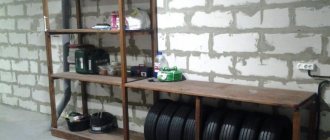We’ll figure out how to best build a garage, what building materials are most profitable to build it from, and how to choose a project that suits your site and the style of the house. After reading the article, you will be able to properly optimize your construction costs without losing the quality of the project.
Stylish and durable garage Source homify.com
Choosing a location for a garage
First of all, you need to decide on the location of this building. Firstly, the location of the garage should be convenient, and secondly, this building should fit into the overall style and be in harmony with other buildings located on the site. The garage can be located separately from other buildings or serve as an addition to any building.
- Detached garage . Quite often, owners use this option, especially if the house has already been built, although a garage can be attached to the house at any time.
- A garage that is part of some kind of building . A garage can be attached to a house or other outbuilding, and the garage is built together with the construction of a house or outbuilding, as well as after the construction of buildings.
As a rule, the garage is located separately from other buildings if it is being built independently, especially since the car appears a little later, when the issue of housing has been resolved. In addition, building a garage separately does not require too much money, and from a technical point of view it is much simpler. When choosing a site, it is necessary to take into account that the garage should be located at a distance of 1 meter from the neighboring site, and the entrance to the garage should be located at a distance of 10 meters from the windows of the neighbor’s house. The distance to the nearest residential building, if it is built from fire-hazardous materials, must be at least 15 meters and at least 9 meters if it is built from non-combustible materials.
The gate opens directly onto the street - one of the good options
Is it worth building?
To understand the feasibility of using wooden logs for building a garage, you need to figure out when to do this and when not to:
- When there is no room to build a deep foundation. Such a garage will not require a powerful foundation, since the logs themselves are light in weight. You can build the foundation yourself; the strip version is perfect for this.
- When it is necessary to build a structure in a short time. If the issue of creating space for a car is urgent, then the option of a wooden log garage will come in handy.
- All buildings on the site are made of this material. A log garage will look more harmonious against the background of a log house than a garage made of blocks.
- A small amount of funds for construction. The construction of a structure from logs will be inexpensive.
In addition, this option should be chosen when you do not plan to hire a team of workers. All work can be done on your own with the assistance of one assistant . The end result is a warm box where you can store the car and service it.
But there are also several cases when building a log garage does not make sense. This includes climate conditions when the weather is predominantly humid and the level of precipitation throughout the year is high.
Dimensions of the garage and its design
First of all, you should decide on the purpose of building a garage. If the garage will only serve as a parking place for a car, then it is enough to add one meter on all sides to the size of the car. These sizes are quite enough. If you plan to carry out repair work, then these sizes are clearly not enough, considering that you will need a lift, an inspection hole, and a lot of tools and spare parts. You will have to add another meter to the dimensions in all directions. If you plan to repair not only your own car, then these dimensions will not be enough.
Is a viewing hole necessary?
The presence of a pit makes the project somewhat more expensive. Some owners built a basement under the garage for storing fruits, vegetables, canned food, etc. Naturally, the arrangement of a basement involves large volumes of excavation work.
If you build only a viewing hole in the garage, about 1 meter wide and no more than two meters deep, then it will cost much less. Naturally, the depth of the hole should take into account the height of the car owner, adding about two dozen centimeters to the height. The length of the pit is no more than two meters. As a rule, this is enough to inspect any passenger car.
An example of the construction of an inspection pit
Nowadays, only a few equip their garages with inspection pits, since repairing modern cars is a responsible task that cannot be solved without specialists, so they use the services of a service station. In addition, it is much easier and faster to build a garage without an inspection hole, simply by pouring the floor in the garage with concrete.
Garage foundation options
Considering the fact that a garage for a passenger car is not impressive in size, you can use any type of foundation, as well as their simplified versions, although this approach largely depends on the nature of the soil and weather conditions in the region.
Strip foundation
Strip foundations are considered the most reliable and also the easiest to manufacture. First of all, you should pay attention to the nature of the soil and the level of groundwater, since you will have to lower the foundation below the freezing depth. If we take the middle strip, then this is a level of 1.7-1.9 meters. It is to this depth that a trench should be dug under the foundation, after which the formwork is installed. Then the space is filled with a frame made of reinforcement and poured with concrete. When the concrete has hardened to 50 percent strength, the formwork is removed and the flooring in the garage begins to be poured.
Strip foundation ready for pouring concrete
If groundwater lies at a considerable depth and the soil is not heaving, then a prefabricated strip foundation or a shallowly buried strip foundation, with a strip height of no more than half a meter, is sufficient. A prefabricated strip foundation is formed on the basis of prefabricated blocks, which are connected to each other using cement-sand mortar.
Alternatively, the strip foundation is poured at ground level, and then the foundation is raised by covering it with reinforced concrete slabs.
Pile or pile-grillage type of foundation
It is considered an economical type of foundation, but it is rarely used in the construction of garages. If you make a purely pile foundation for a garage, then it is not very convenient, since the floor of the garage rises to a certain level above the ground. In this regard, it is necessary to think about organizing a check-in. Pile and pile-grillage types of foundations are ideal for construction on heaving soils with a high groundwater level.
The pile is connected to the grillage - this is a pile-grillage foundation
The construction of a pile-grillage foundation is based on digging a pit up to half a meter deep, and then drilling wells in the pit in increments of one and a half to 2 meters. Wells are drilled to the depth of soil freezing. Formwork in the form of pipe sections or rolled roofing felt is inserted into the wells. After this, several bars of reinforcement are inserted inside the formwork so that they protrude from the formwork by 0.7 meters. All this is filled with concrete (wells with formwork). Then they begin to install the formwork on the tape, making a frame from reinforcement so that there is a connection with the reinforcement coming out of the concrete-filled piles. Finally, the entire structure is poured with concrete.
Monolithic reinforced concrete slab
A monolithic reinforced concrete slab is a solution to the problem for any type of soil. Its dimensions are larger than the size of the garage itself by about 0.3 meters in all directions. First of all, the ball of the fertile soil layer is removed, and then a pit is dug at a depth of 0.5 meters. After this, the bottom of the pit is leveled and a layer of gravel about a quarter of a meter thick is poured onto it. The most important thing is that the gravel layer is well compacted, preferably using a vibrating plate.
Formwork is installed along the perimeter of the pit, after which reinforcement is installed in increments of up to 20 cm, both along and across. The result is a grid with cells approximately 20x20 cm. Such a grid should be located in 2 tiers, with a distance of 20 cm. Finally, this structure is filled with concrete.
Both the floor and the foundation
Wall installation
There are many options for making walls, but cheap, non-combustible materials, in the form of foam blocks and gas blocks, are considered the most acceptable, especially since they minimize the load on the foundation, and construction does not take much time. In addition, the walls are warm and heating the garage to a comfortable temperature does not require any special expenses or special heating systems, since it is enough to install a small stove. Naturally, exterior finishing will be required in the style of finishing of other buildings, so as not to disturb the harmony of the overall appearance.
The second option and often used is frame construction, followed by installation of wall material. If the frame is metal, then the walls will be made of metal, and if the frame is made of wood, then the walls can be anything, including metal. In this case, we are talking about a cheap garage that serves as a temporary parking lot for a car.
Frame garage for a country house
Roof arrangement
The simplest option, which is used quite often, is a flat roof with a slope of 8 to 12 degrees. The greater the slope, the less precipitation is retained on the roof. If the garage is located separately, then the roof is raised at the front so that precipitation falls from the rear of the garage. If the garage is attached to one of the outbuildings on the site, then the slope is made in the direction of this building. The disadvantage of a pitched roof is the fact that there is no attic in the form of additional usable space. The advantages are obvious, since the installation of such a roof requires a minimum of resources, and the ease of installation allows anyone to do it.
An example of a gable roof rafter system
The design of a gable roof is somewhat more complicated, and it is also more expensive. In addition, more roofing material is wasted and residues appear. Despite this, this design has a more attractive appearance. The new attic space allows for a more rational distribution of all things, and there can be a lot of them. Some owners build an attic above the garage, which can serve as a room for receiving guests. Naturally, the attic is even more expensive, but it provides a decent amount of additional space.
Gate design
Previously, garages were mainly equipped with swing gates made of metal, but nowadays, many use more modern lifting gates with automatic control. In addition, there are also sliding gates.
Sliding gates are used when the exit from the garage is in the same plane as the fence of the site, although to implement this option it is necessary to have a free section of the wall, the length of which is one and a half meters greater than the width of the gate. This option is good when using a garage in winter, since the gate is easy to dig out if it is covered with snow.
Lifting gates are the most expensive, as they are equipped with a lifting mechanism, but they are the most convenient in any regard. As an option, you can use roller shutters, especially not automated ones, since their cost is not so high. The color can be any, but the roller blinds should be thicker.
Naturally, the automated design is more modern and more convenient. The design of the gate opening must be thought out immediately taking into account the design of the lifting mechanism. Sectional models are more convenient, since when folded they take up little space, but their cost is decent.
Homemade vertical garage doors
-2
Garage interior decoration
Often, car owners do not pay attention to the beauty of the garage walls and leave everything as is after construction. Despite this, some building materials require protection from moisture, otherwise the service life of the walls is reduced significantly. In this case, you can get by with regular plastering of the walls, followed by whitewashing with lime.
Plaster is the best finish
If the garage is frame, then it can be sheathed on the inside with plywood. For a garage that is planned to be heated, any type of plywood is suitable, but for garages that are not heated, it is better to choose moisture-resistant plywood. In any case, any sheet material will do.
Materials for production
The supplies and tools for making such a craft are quite simple. There is no need to run to the store and buy everything you need, because consumables can be found on the desktop of any creative person. So, to create a parking lot you will need:
- cardboard boxes of different sizes;
- paper knife or scissors;
- a simple pencil;
- colored pencils, felt-tip pens and watercolors will help make your garage bright and colorful;
- eraser;
- masking and stationery tape;
- ruler;
- machines to determine the size of the parking space and the size of the gate;
- imagination and help of a child.
If you have all this, then you can start creating a masterpiece!
Garage insulation and heating
When using a garage all year round, you need to think about how the walls can retain maximum heat by using materials with a low thermal conductivity coefficient for its construction. Garages made using frame technology will have to be carefully strengthened. For insulation, building materials such as mineral wool or, in extreme cases, polystyrene foam are used. Low-density foam concrete is suitable as a non-flammable insulation. It doesn't burn, holds heat well and is cheap. It is simply laid between the frame posts. It should be borne in mind that it should not be loaded, and fasteners must be installed in the places where the racks of the frame structure pass.
Heating in the garage can be made constant or periodic, and it can be separate or represent a separate branch from the house. Separate heating is quite expensive, as it represents a full-fledged heating system, albeit in a reduced form. Despite this, it must be monitored and maintained.
The solution to the problem is to connect the garage to the heating system of the house using a separate pipeline line. If the garage is attached to the house, then the problem is solved quite simply, but if it is located at a considerable distance, then this issue is not so easy to solve. Firstly, it is necessary to provide good thermal insulation for this branch. Secondly, you will have to work a lot to dig a deep trench that would be deeper than the freezing level of the soil. As a rule, everything comes down to costs, especially if you don’t do everything yourself, but hire workers.
Periodic heating can be organized by installing a “potbelly stove” type stove or its modification in the garage. To get heat, you can burn wood and other unnecessary rubbish, which is also useful.
Naturally, organizing this type of heating in a garage is quite simple, but there are some nuances that negatively affect the use of this option. If you heat such a stove, then the heat is mainly near the stove, and while the entire garage room is warming up, a lot of useful time will be spent, although this does not frighten car lovers at all, since they are ready to sit in the garage for even days.
My garage and my car
Foundation work
Pouring a monolithic foundation
Scheme
A high-quality and reliable foundation is the basis of any structure. The choice of technology for constructing a foundation depends on many different factors: the design of the structure, the characteristics of the soil, the financial capabilities of the owner, etc.
Basically, for the construction of a garage, the base is a concrete slab poured using monolithic technology.
The concrete slab will serve as a subfloor, which can then be lined with any finishing materials. Being a type of “floating” foundation, a concrete slab absorbs evenly high loads, helping to avoid deformation of the structure during its operation.
To construct a monolithic foundation, a shallow trench is dug around the perimeter of the planned building and formwork is installed. First, make a cushion of sand and gravel and compact it. Then the base is reinforced with two meshes of metal rods, preparing the site, and it is filled with concrete. After this, the foundation must be allowed to stand for about 3 weeks.
Schemes and drawings of garages
Materials for the construction of a frame garagePhoto gallery
There are many options for creating a garage for cars. We invite you to look at photos of the most interesting crafts: maybe this is where your dream parking lot is located? If you would like to receive a master class on a specific garage, leave your wishes in the comments, and we will definitely review an interesting model.
To make a garage out of cardboard for cars with your own hands, you don’t need to be a genius: it’s enough to love your baby and learn creative lessons with interest with the whole family. Thank you for being with us!
Photo reports about construction
Not all construction processes can be understood by simply reading about them, but with drawings or photographs everything becomes much clearer. Many questions arise when building frame garages, since these structures are less expensive and are built much faster.
Wooden frame garage
The garage dimensions are 4x6.5 meters, plus a gazebo measuring 4x2 meters. All building materials were delivered in advance, treated with an antiseptic and stacked to dry.
Materials for the construction of a frame garage
A columnar type of foundation was used as a foundation. Using a hand drill, holes with a diameter of 35 centimeters were made to a depth of one and a half meters. As formwork, sleeves made of roofing felt were used, into which 3 rods of reinforcement were inserted, after which the sleeves were filled with concrete.
Concrete piles using drilled-rammed technology
After a couple of weeks, when the concrete is almost completely mature, you can begin to build the walls, starting with the bottom frame, using wooden beams measuring 150x100 mm. On the side where the gate is supposed to be installed, the beams are not laid.
It should be said right away that in this case the idea with reinforcement is not entirely correct, since it is problematic to fasten it to the lower trim. In this option, we had to use anchors that were fixed in concrete.
Bottom harness
The next stage is the installation of racks, which are installed in increments of one and a half meters above each foundation column. The racks are installed strictly vertically, starting from the corners. Each post is fixed using temporary bevels, which are secured with nails. All racks must be level, both vertically and in a plane. The posts are secured with nails and then reinforced with metal mounting plates.
To prevent the loose ends from moving apart, it is better to fasten them with a board (temporarily, of course).
Vertical racks
Having installed all the racks, you can fasten the logs, which will add rigidity to the entire structure, since the next stage is associated with the installation of the upper trim.
Top harness in place
To provide greater rigidity, it is better to install additional intermediate posts with jibs.
We continue to assemble the garage frame
When the beams and racks are mounted and securely connected to each other, proceed to the installation of the rafter system. The roof is of a sloping type, and is also temporary, since this is the first building on the site, and in the future it is planned to build a house next to the garage.
View from the other side
After assembling the required number of trusses on the ground, they are installed on the top frame, secured with boards on both sides. The trusses are then fixed in the correct position using nails and reinforced using metal angles secured with self-tapping screws.
Assembling the rafters
The rafters should be installed strictly vertically so that expanding loads do not occur, otherwise the roof may move (deform).
Installing rafters on the roof
Rafters from below
The next stage is installation of the sheathing, for which a 40x150 mm board is used. It can be mounted in increments of 400 mm.
Lathing, on non-roofing material
Finally, corrugated sheeting is installed and attached to the sheathing.
Roofing sheeting on the garage roof
When the roof is ready, construction of the garage continues with strengthening the gate area. To do this, the beams should be secured at the top and sides of the opening.
At the same time, they began to design the gate area
Since it is planned to install up and over gates, a special frame - a guide - should be welded inside the garage. For this, a profile pipe measuring 25x50 mm is used, from which the gate frame is also welded taking into account the size of the opening, as well as with a small gap.
Up and Over Door Frames
After completing all the preparatory work, they begin to sheath the frame using DSP boards. Sheets are easily processed using a grinder with a diamond wheel installed. It should be said right away that there is a lot of dust.
They brought the DSP
DSP sheets are attached with a gap of about 10 mm so that they can expand or contract depending on temperature and humidity.
Sheathing has begun
Sheathing continues
View from the gazebo
This is an already installed gate
Despite the fact that there is still a lot of work, you can park your car in the garage, and you can drink tea in the gazebo.
Painting is a simple matter
Before painting, the garage boards should be cleaned with a sanding disc using an angle grinder. Since this process is quite dusty, you need to protect your eyes and respiratory tract using goggles and a respirator (or disposable masks).
Modern industry offers a huge selection of biotex shades for wood. We used biotex “Pear” in two layers.
Gate manufacturing
The swing gates for the garage were welded from a 40 × 20 metal pipe. The opening is 3000 wide and 1900 high.
C8 corrugated sheet is attached to the pipe structure. The color in the photo is chocolate.
Garage driveway deck
The flooring is made of 50 × 150 boards. For its construction, the remains of logs from an old garage, timber, stones, and so on were used.
DIY track made of foam plastic (cardboard) for children's cars.
A track for cars that can be made with children and for children. Fast, clean, easy and economical. All we need is:
- white polystyrene foam, if you don’t have it, you can use large cardboard, pre-painting it;
- decorative tape;
- scissors;
- wooden cubes, if you don’t have them, you can use any building blocks that you have at home;
- brushes
We paint the wooden cubes with acrylic paint. The colors can be any, we have pastel colors of yellow, carrot, and blue. We mark the route with a simple pencil, then cover it with decorative tape. That's all, the track is ready. You can play with it at home or on the street. Easy to store because It's flat, so you can hide it under the bed or behind the closet.
DIY children's racing track
- Samodelkin
- January 2, 2016
- Crafts for children
Today we have a master class for parents. Let's make an exciting auto racing track ourselves and start a competition to see whose car goes the furthest.
In the arsenal of every parent there are many ideas that they are ready to use when the child is already bored with all his toys. And if it’s not possible to go outside, then your imagination has no value.
Look at what my son inspired me to do while playing with cars. It started with the fact that we wanted to make a jump on the track. But, after working with available materials - cardboard boxes and double-sided tape, the idea took on slightly different shapes and the result was an auto racing track equipped with a traffic light inside.
A traffic light on the track and a jump on a section of the track.
Give your child some of your time, make an exciting game with him using scrap materials, and in gratitude you will be his best friend.
DIY car wash made from a cardboard box.
Cool idea for summer time. You can play with such a car wash on the street, in your dacha, as you can actually wash children’s cars there. Children simply love to play with water. And here you can spray cars with a spray bottle.
To make a children's toy we will need:
- cardboard box;
- cellophane to cover the walls and floor of the car wash;
- felt;
- wooden rolls, and two toilet paper rolls;
- scissors, hot glue.
We start work by cutting off the roof and one side of a cardboard box, and on the opposite side we make something like a door. Next we start painting. We need to paint all the outer walls and the bottom of the box, this way we will protect it from moisture.
After the box is dry, glue cellophane to the inside. You probably guessed that this will save the box from moisture and it will last longer. We cut the felt and glue it to wooden bushings (you can also sticks), to toilet paper bushings. We attach everything to our car wash. Children can play with this toy for hours.
What will you need?
To make a toy plywood garage, you will need to stock up on certain materials and tools. The craftsman also needs to have drawings according to which the parts will be made. You should think in advance about the size of the product so that there is enough space in it to accommodate children's cars of all sizes and shapes.
So, you need to prepare the following tools and materials in advance.
Plywood. In this case, it is advisable to take a sheet 0.3 cm wide. This size will make the product durable, while working with such material is not so difficult.
You should also prepare a sheet of paper or whatman paper to make a drawing, take a pencil and a ruler. You can make a drawing for a toy plywood garage yourself or take ready-made models from the Internet. According to users, the PRO100 program will help create a drawing for a future garage.











